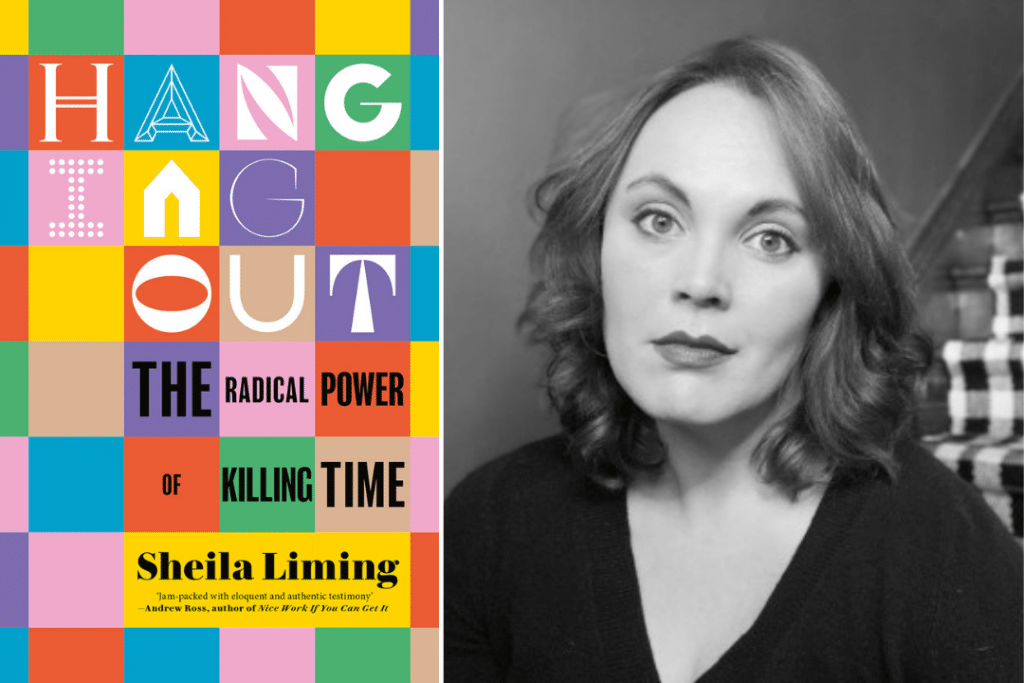Almost every day it seems like our world is becoming more fractured, more digital, and more chaotic. Sheila Liming has the answer: we need to hang out more. She’s just released book on the topic, Hanging Out: The Radical Power of Killing Time, published by Black Inc. Books.
Liming outlines the case for unstructured social time as a key to our vitality — examining what hanging out actually is, why it’s important, how we do it and the various ways we do it. She demonstrates how actually coming together to “hang out” can be a powerful act of resistance on its own.
In this extract, Liming asks how we moved from having parties that were about having fun, to parties that are about collecting experiences and putting out the perception that you’re having fun — by sharing digital proof of the party on social media. She goes back to 2005, the year that Facebook “broke” onto her university campus.
This is a non-Facebook party.
This is what it says on the back of the invitation, which is a paper invitation, and which I probably received some time during the spring of 2005. A long time ago, in other words—a whole, other world ago.
This invitation came to me through my campus mailbox, back when that was how things worked, or at least how they worked for us at the small Ohio college where I was an undergraduate. Students at the College of Wooster were assigned to physical mailboxes located in the campus center. The boxes in question were old, though not as old as I liked to imagine them—they probably only dated from the 1950s or ’60s—and made of decorative brass. The combinations for the preset locks never changed. If you graduated and then came back to visit, you could open up a stranger’s mailbox by using the old sequence of letters and numbers to work the quaint little brass dials. And they were tiny, these boxes, capable of holding only a few letters or handwritten notes.
The notes got deposited through a slot on the door of the box. This system had its advantages: it allowed the note’s author to bypass campus mail, and along with it, the prying eyes of student mail workers. In that way, they were like the direct messages (in contemporary social media parlance) of their time—private, targeted, intimate. Meanwhile, magazines and packages and anything of that sort had to be picked up separately, at the front desk. Which is why they aren’t there anymore, the old brass mailboxes; which is why ones just like them are now sold as nostalgia objects on sites like eBay and Etsy.
Back then, we students used to check our mailboxes a dozen or so times each day—on our way to meals in the cafeteria, which was located upstairs, or between classes. From those little brass boxes came good news in the form of scholarship announcements, class schedules, and dean’s list notifications, and also less good news in the form of tuition bills and academic probation warnings. Graduate program acceptances came to me through my own little brass box. So did rejections. So did notes from secret admirers. So did invitations to parties.
The students who threw those parties, and sometimes I was one of them, would make up print invitations, duplicate them on library Xerox machines, and then slip them through the slots on the front of those mailboxes. The invitations were whimsically crude little things, more like zines than formal missives, featuring cut-and-paste collage images, hand-drawn graphics, and announcements scrawled in Sharpie. For most parties, a print invitation wasn’t necessary, but it was a way of knowing that, were you to show up, you might find yourself officially welcome.
I don’t remember any of these parties. Which is to say, I remember all of them all at once, mashed together into a kaleidoscopic slurry of memory. But I don’t retain impressions of what they meant as individual instances. That includes this particular party, the one mentioned on the print invitation in question, which I still have.
This is a non-Facebook party.
What did that phrase mean to us in 2005? That was the year that Facebook “broke” on our campus, as it did on so many others. It was also the year that Facebook “broke,” in a different sense, our old methods of social interaction and started rewiring our expectations for collective ritual. And what, I can’t help but wonder, does that phrase mean today, now that parties are more likely than not to be facilitated via sites like Facebook—to take place on sites like Facebook, even, maybe, via livestream technology?
My friends Joe and Ronny sent me this print invitation to a designated “non-Facebook” party that happened almost twenty years ago now. It started at 11 p.m., the invitation tells me, and took place, as all our parties did, in a dorm room. The “non-Facebook” part was meant as a reference to the manner in which invitations were to be distributed. Already in 2005, after less than a year of living with Facebook and its slowly tightening chokehold, we knew what was happening: we could smell the impending changes in the air. The phrase “non-Facebook” was a way of announcing that the party in question would be organized around the old social networks—people who were already friends, or friends-of-friends, and thus part of an existing web of affiliation, as opposed to a categorically generalized and algorithmically selected one.
This method was supposed to stand in contrast to other, newer kinds of parties, “Facebook parties.” Invitations to them were distributed online via the social networking platform, usually to anyone and everyone who had a Facebook account linked to our college. This was back when Facebook accounts were still being offered exclusively to college-age populations and were therefore tied to users’ institutions—back before our uncles and grandmothers joined the site, before coffee shops and pizza restaurants and bands and municipalities all had their own profiles.
As a result, Facebook parties, back in 2005, constituted something of a paradox, viewed on the one hand as exclusive (because Facebook itself was still exclusive) and on the other as democratic (because for many of them, all you had to do to get invited was be on Facebook). I wasn’t on Facebook in 2005. Indeed, to this day, I’ve never been. So I didn’t get invited to those other parties, the Facebook-friendly ones.
But sometimes I tagged along with others who did and I remember witnessing the change, which was not slow and gradual but fast and feverish, actually.
You could tell a Facebook party by the photos. The point was to post them to Facebook the next day so everyone could like and distribute and repost as needed. I think this may have felt, at first, like a way of keeping the party going. But it soon revealed itself as a form of vulgar promotion that, over time, started to feel less vulgar and simply habitual, instead. The party had to be advertised, both before and after it happened, and so did the attendees.
One had to like and distribute and follow back in order to lay claim to a certain status as a person considered worthy of inclusion, even though the process by which one had been selected for inclusion was itself non-selective. It became a game, a race. People started to collect friends, experiences, and parties like trading cards, hoarding them away in their online personality silos. The parties themselves, they stopped being about having fun and started being primarily about looking like you were having fun—about advertising your own capacity to have fun.
Hanging Out: The Radical Power of Killing Time is published today by Black Inc. Books. You can find out more about Sheila Liming and the book here.



